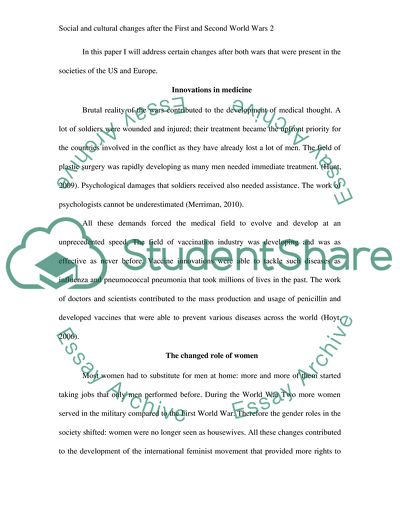Cite this document
(“Social and Cultural Changes after the First and Second World Wars Essay”, n.d.)
Social and Cultural Changes after the First and Second World Wars Essay. Retrieved from https://studentshare.org/history/1593297-social-and-cultural-revolution-was-one-of-the-effects-of-the-world-wars-please-compare-how-wwi-and-wwii-impacted-on-class-and-gender-relations-as-well-as-the-effects-they-had-on-the-arts-sciences-and-thought
Social and Cultural Changes after the First and Second World Wars Essay. Retrieved from https://studentshare.org/history/1593297-social-and-cultural-revolution-was-one-of-the-effects-of-the-world-wars-please-compare-how-wwi-and-wwii-impacted-on-class-and-gender-relations-as-well-as-the-effects-they-had-on-the-arts-sciences-and-thought
(Social and Cultural Changes After the First and Second World Wars Essay)
Social and Cultural Changes After the First and Second World Wars Essay. https://studentshare.org/history/1593297-social-and-cultural-revolution-was-one-of-the-effects-of-the-world-wars-please-compare-how-wwi-and-wwii-impacted-on-class-and-gender-relations-as-well-as-the-effects-they-had-on-the-arts-sciences-and-thought.
Social and Cultural Changes After the First and Second World Wars Essay. https://studentshare.org/history/1593297-social-and-cultural-revolution-was-one-of-the-effects-of-the-world-wars-please-compare-how-wwi-and-wwii-impacted-on-class-and-gender-relations-as-well-as-the-effects-they-had-on-the-arts-sciences-and-thought.
“Social and Cultural Changes After the First and Second World Wars Essay”, n.d. https://studentshare.org/history/1593297-social-and-cultural-revolution-was-one-of-the-effects-of-the-world-wars-please-compare-how-wwi-and-wwii-impacted-on-class-and-gender-relations-as-well-as-the-effects-they-had-on-the-arts-sciences-and-thought.


